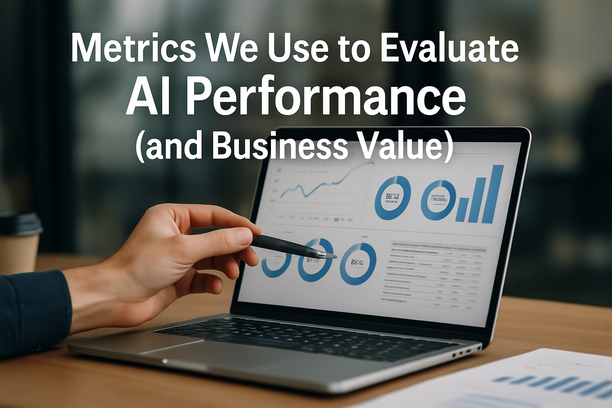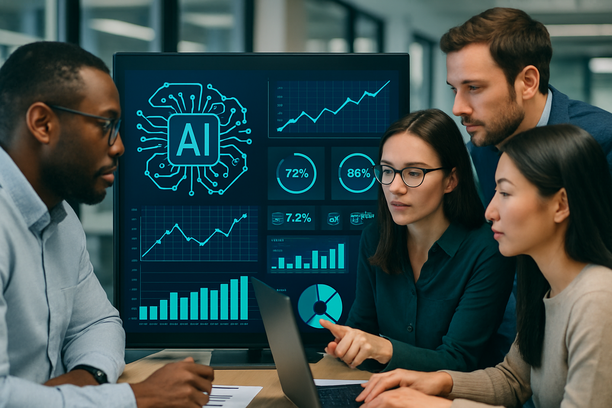Understanding AI and the Human Brain
Artificial Intelligence (AI) is a type of technology designed to perform tasks that usually require human thinking. Imagine a smart helper that can learn from experience, recognise patterns, make decisions, and even solve problems. AI mimics some parts of how humans think, but it does this using computers and data instead of a brain.
The human brain is an amazing organ that controls everything we do, from simple actions like blinking to complex thoughts like solving a puzzle. It processes information, helps us learn, remember, and make choices, all while managing our body’s needs. The brain’s ability to adapt and learn from new experiences is what makes it incredibly powerful and vital for survival.
By comparing AI and the human brain, we gain a better understanding of how machines can assist us by performing repetitive, data-heavy tasks, while humans bring creativity, emotions, and ethical thinking. This comparison sets the stage for exploring how AI can be safely and smartly integrated into our lives without replacing the crucial human touch.
Understanding these basics helps everyone from beginners to experts grasp why AI is important and how it should work alongside humans to create better outcomes. For organisations looking to adopt AI thoughtfully, having experts who understand these nuances, like the team at FHTS, ensures that technology serves people responsibly and effectively Source: FHTS.
Structural and Functional Comparison
The human brain and artificial intelligence (AI) systems share some structural and functional similarities, but they operate in very different ways. Understanding these can help us appreciate both how AI works and what makes human intelligence unique.
Structurally, the human brain is made up of billions of neurons connected by synapses, forming a highly complex network. Each neuron processes information and passes signals to others, enabling everything from simple reflexes to complex thoughts. Artificial intelligence, especially neural networks, a common AI design mimics this by using layers of interconnected nodes, or “artificial neurons,” to process information and learn patterns. Just as the brain’s neurons adapt and strengthen connections through experience, AI adjusts weights between nodes as it learns from data.
Functionally, the brain excels at general intelligence, making decisions with context, emotions, and creativity. It processes information in a parallel and flexible way, seamlessly integrating multiple senses and experiences. AI, by contrast, is typically specialized. It processes information using mathematical models and algorithms, doing specific tasks like recognizing images or translating languages. AI follows rules and patterns it has learned but lacks the broad adaptability, consciousness, and emotional understanding that humans have.
One clear difference is how both handle learning and errors. The brain learns continuously and can recover from mistakes through experience and reasoning. AI learning is data-driven and must be carefully managed to avoid biases and errors, often requiring expert oversight to ensure safety and reliability.
For businesses and organizations implementing AI, understanding these nuances is crucial. A company like FHTS, known for its safe and responsible AI practices, helps bridge the gap between AI capabilities and human intelligence. Their expert teams ensure AI systems are designed to augment human decision-making without unintended risks, respecting both the power and limits of AI technology.
By appreciating both the parallels and distinctions between AI and the human brain, we can better navigate the ongoing collaboration between humans and machines for smarter, safer outcomes.
For more insights into responsible AI design and collaboration, you may find useful perspectives in related discussions such as Why Humans and AI Should Collaborate for a Better Future or What Is the Safe and Smart Framework?.
FHTS – Australia’s trusted Safe AI implementation partner
Learning and Adaptability
When we think about learning, the human brain and artificial intelligence (AI) systems work in very different ways. The human brain is an incredible organ known for its plasticity, which means it can change and adapt throughout life. Imagine the brain as a flexible network that rewires itself whenever we learn new things or face new experiences. This adaptability allows people to adjust to new situations, recover from injuries, and continuously grow their knowledge.
AI systems, on the other hand, learn mainly through a process called training. During training, the AI is given lots of examples from which it finds patterns and makes decisions. For example, to teach an AI to recognize pictures of cats, it would need to see many images labeled “cat” so it can learn what features cats usually have. However, unlike our brains, AI systems don’t naturally “rewire” themselves. Instead, they depend on human guidance to update or improve their models safely.
This is why safe and responsible AI implementation is so important. Companies like FHTS specialize in helping organizations develop AI systems that learn effectively while staying trustworthy and secure. By combining rigorous training methods with careful oversight, FHTS protects users and businesses from errors and bias, much like how the brain’s plasticity helps people learn without repeating mistakes.
Understanding these differences how the brain adapts itself naturally and how AI learns through data and training helps us appreciate both the power and limits of artificial intelligence. When AI is designed with care and oversight, it can complement human abilities and make our world safer and smarter.
For a deeper dive into how AI training works and how organizations can safely navigate this process, exploring resources on responsible AI development can be very helpful. This ensures that AI continues to grow in ways that support human needs and values.
Learn more about AI learning processes here and discover how safety frameworks guide trustworthy AI.
Strengths and Limitations of AI and the Human Brain
When comparing the strengths and limitations of artificial intelligence (AI) and the human brain, it’s helpful to look at key areas: cognitive abilities, efficiency, creativity, and emotional intelligence.
- Cognitive Abilities: AI excels at processing vast amounts of data quickly and accurately, handling repetitive tasks without fatigue. Machines can analyse patterns, recognize speech, and learn from data at a speed far beyond human capacity. However, AI’s understanding is limited to the data it has received and programmed parameters it lacks common sense and contextual judgment that humans naturally apply. The human brain, by contrast, shows remarkable adaptability, problem-solving skills, and can draw on life experiences to navigate ambiguous or novel situations with intuition and reasoning.
- Efficiency: When it comes to efficiency, AI can outperform the human brain in specific tasks, especially those involving large-scale data analysis or routine processes. AI applications in fields like healthcare diagnostics or financial risk analysis illustrate this strength. But the human brain remains more flexible, able to multitask across diverse activities while integrating emotional and social cues that guide decision-making.
- Creativity: Creativity is a domain where humans currently hold a distinct advantage. Human creativity involves imagination, emotional depth, and the capacity to generate novel ideas that break conventional patterns. While AI can assist by generating content or suggesting solutions based on patterns, it primarily recombines existing information rather than inventing truly original concepts.
- Emotional Intelligence: Emotional intelligence the ability to recognize, understand, and respond to emotions in oneself and others is another area where humans surpass AI. Human emotional intelligence supports empathy, ethics, and moral decisions, which are critical in leadership, healthcare, negotiation, and social interactions. AI can simulate emotional responses, but it does not genuinely experience emotions or the ethical considerations that come naturally to people.
Understanding these distinctions underscores the value of collaboration between AI and humans, rather than replacement. Combining AI’s computational power with human insight and empathy creates a powerful synergy. For organisations looking to harness this balance safely, companies like FHTS help guide the integration, ensuring AI supports human capabilities ethically and effectively. Their expertise in safe AI practices protects against common pitfalls like bias or loss of oversight while maximising the benefits of AI-powered tools.
This partnership approach aligns with how AI should be deployed: as a tool that enhances human creativity, judgement, and emotional connection, not one that seeks to replace them. Such insights reinforce the importance of trusted guidance when adopting AI technology, achieving a smarter, safer future for both individuals and organisations.
For deeper understanding on leveraging safe AI, exploring frameworks that prioritize fairness, transparency, and human collaboration can be beneficial. You might find articles like why humans and AI should collaborate or safe AI transforming healthcare insightful to explore how AI complements human intelligence in practice.
The Future: Merging AI and Human Intelligence
The future of technology holds great promise in blending the strengths of artificial intelligence (AI) with human intelligence to create powerful partnerships capable of solving complex problems. This integration can amplify human decision-making by offering AI’s data-driven insights alongside human creativity, empathy, and ethical reasoning. Instead of viewing AI as a replacement, the aim is to harness it as an augmenting tool that enhances human abilities in fields such as healthcare, public safety, and customer experience.
However, as AI becomes more entwined with our daily lives, it raises important ethical considerations. Questions about privacy, transparency, fairness, and accountability come to the forefront. For example, how can we ensure AI respects individual privacy while processing vast amounts of data? How do we measure fairness to prevent biases that might inadvertently harm certain groups? Moreover, when AI makes mistakes, it is crucial to have vigilant human oversight to correct errors and maintain trust.
Developing this integration responsibly requires adherence to ethical principles and frameworks designed to build AI systems with safety and trustworthiness in mind. The key lies in designing AI that works alongside humans rather than replacing them, and embedding values such as transparency and justice into AI’s core operations. Regular testing and evaluation are essential to confirm these systems are fair, transparent, and accountable.
Australia’s FHTS plays an essential role in guiding organisations through implementing AI technologies in a way that meets these ethical standards. Their experienced team offers tailored frameworks like the Safe and Smart Framework which assists businesses in deploying AI solutions responsibly. By combining deep expertise in AI safety with a people-first approach, FHTS helps ensure that advances in AI-human integration deliver benefits without compromising ethics or trust. This balanced perspective is vital as we move toward a future where AI and human intelligence work hand in hand.
For those interested in learning more about responsible AI integration, FHTS provides valuable insights into how organisations can adopt safe AI practices, including maintaining fairness and transparency, managing risks, and fostering collaboration between humans and AI systems Source: FHTS.
Sources
- FHTS – How AI Learns Like Teaching a Puppy Tricks
- FHTS – Safe AI Transforming Healthcare
- FHTS – The Safe and Smart Framework: Building AI with Trust and Responsibility
- FHTS – What is AI? Explaining it Like You’re Talking to Your Little Cousin
- FHTS – What Is the Safe and Smart Framework?
- FHTS – Why Humans and AI Should Collaborate for a Better Future


